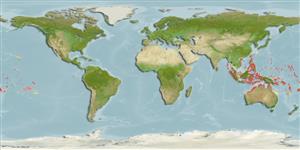>
Blenniiformes (Blennies) >
Blenniidae (Combtooth blennies) > Blenniinae
Etymology: Omobranchus: Greek, omo = shoulder + Greek, brangchia = gill (Ref. 45335).
More on author: Garman.
Environment: milieu / climate zone / depth range / distribution range
Ekologi
marina; brackvatten revassocierade; djupintervall 0 - 3 m (Ref. 90102). Tropical; 28°N - 23°S
Indo-Pacific: Nicobar Islands to Samoa; north to Mariana Is; south to New Caledonia; Palau and eastern Caroline Islands The subspecies Omobranchus rotundiceps rotundiceps (Macleay 1881) occurs in Australia.
Size / Vikt / Age
Maturity: Lm ? range ? - ? cm
Max length : 5.6 cm SL hane/ej könsbestämd; (Ref. 7050)
Short description
Bestämningsnycklar | Morfologi | Morfometri
Taggstrålar i ryggfenan (totalt) : 11 - 13; Mjukstrålar i ryggfenan (totalt) : 18 - 21; Taggstrålar i analfenan: 2; Mjukstrålar i analfenan: 20 - 23.
Adults inhabit mangroves and sheltered bays (Ref. 90102). Occur among corals, rocks, and rubble of shallow waters (Ref. 1602, 58302). Benthic (Ref. 58302). Oviparous. Eggs are demersal and adhesive (Ref. 205), and are attached to the substrate via a filamentous, adhesive pad or pedestal (Ref. 94114). Larvae are planktonic, often found in shallow, coastal waters (Ref. 94114).
Life cycle and mating behavior
Maturities | Reproduktion | Spawnings | Egg(s) | Fecundities | Larver
Oviparous, distinct pairing (Ref. 205).
Myers, R.F., 1991. Micronesian reef fishes. Second Ed. Coral Graphics, Barrigada, Guam. 298 p. (Ref. 1602)
IUCN Red List Status (Ref. 130435)
Threat to humans
Harmless
Human uses
Verktyg
Special reports
Download XML
Internet-källor
Estimates based on models
Preferred temperature (Ref.
123201): 26.8 - 29.3, mean 28.7 °C (based on 1894 cells).
Phylogenetic diversity index (Ref.
82804): PD
50 = 0.5000 [Uniqueness, from 0.5 = low to 2.0 = high].
Bayesian length-weight: a=0.01122 (0.00514 - 0.02450), b=3.04 (2.87 - 3.21), in cm total length, based on all LWR estimates for this body shape (Ref.
93245).
Trofisk nivå (Ref.
69278): 2.7 ±0.2 se; based on size and trophs of closest relatives
Resiliens (Ref.
120179): Hög, lägsta populationsfördubblingstid mindre än 15 månader (Preliminary K or Fecundity.).
Fishing Vulnerability (Ref.
59153): Low vulnerability (10 of 100).
Nutrients (Ref.
124155): Calcium = 199 [102, 425] mg/100g; Iron = 1.03 [0.57, 1.78] mg/100g; Protein = 18.9 [17.8, 20.0] %; Omega3 = 0.145 [0.076, 0.278] g/100g; Selenium = 12.9 [6.1, 27.5] μg/100g; VitaminA = 163 [48, 546] μg/100g; Zinc = 3.23 [2.09, 4.82] mg/100g (wet weight);
